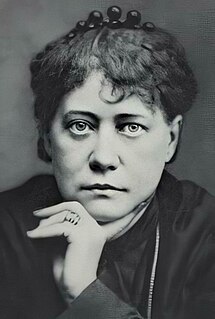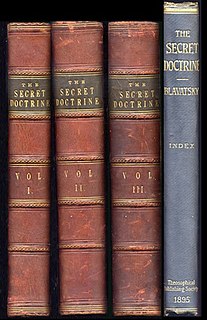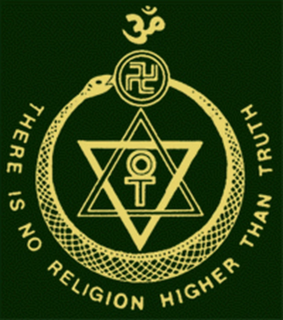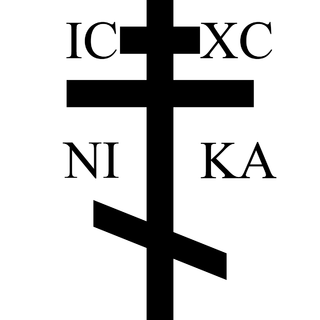Related Research Articles

Helena Petrovna Blavatsky was a Russian author who co-founded the Theosophical Society in 1875. She gained an international following as the leading theoretician of Theosophy.

The Theosophical Society, founded in 1875, is a worldwide body with the aim to advance the ideas of Theosophy in continuation of previous Theosophists, especially the Greek and Alexandrian Neo-Platonic philosophers dating back to 3rd century CE. It also encompasses wider religious philosophies like Vedānta, Mahāyāna Buddhism, Qabbalah, and Sufism. The Theosophical Society functions as a bridge between East and West, emphasizing the commonality of human culture.
Emanationism is an idea in the cosmology or cosmogony of certain religious or philosophical systems. Emanation, from the Latin emanare meaning "to flow from" or "to pour forth or out of", is the mode by which all things are derived from the first reality, or principle. All things are derived from the first reality or perfect God by steps of degradation to lesser degrees of the first reality or God, and at every step the emanating beings are less pure, less perfect, less divine. Emanationism is a transcendent principle from which everything is derived, and is opposed to both creationism and materialism.

Ascended masters in the Ascended Master Teachings of a number of movements in the theosophical tradition are held to be spiritually enlightened beings who in past incarnations were ordinary humans, but who have undergone a series of spiritual transformations originally called initiations.

The Secret Doctrine, the Synthesis of Science, Religion and Philosophy, is a pseudo-scientific esoteric book originally published as two volumes in 1888 written by Helena Blavatsky. The first volume is named Cosmogenesis, the second Anthropogenesis. It was an influential example of the revival of interest in esoteric and occult ideas in the modern age, in particular because of its claim to reconcile ancient eastern wisdom with modern science.

Isis Unveiled: A Master-Key to the Mysteries of Ancient and Modern Science and Theology, published in 1877, is a book of esoteric philosophy and Helena Petrovna Blavatsky's first major work and a key text in her Theosophical movement.
Djwal Khul, is believed by some Theosophists and others to be a Tibetan disciple in "The Ageless Wisdom" esoteric tradition. The texts describe him as a member of the 'Spiritual Hierarchy', or 'Brotherhood', of Mahatmas, one of the Masters of the Ancient Wisdom, defined as the spiritual guides of mankind and teachers of ancient cosmological, metaphysical, and esoteric principles that form the origin of all the world's great philosophies, mythologies and spiritual traditions. According to Theosophical writings, Djwal Khul is said to work on furthering the spiritual evolution of our planet through the teachings offered in the 24 books by Alice Bailey of Esoteric Teachings published by The Lucis Trust ; he is said to have telepathically transmitted the teachings to Bailey and is thus regarded by her followers as the communications director of the Masters of the Ancient Wisdom.
White Lotus Day is a celebration of Theosophists. It is celebrated 8 May, the anniversary of the death of Helena Petrovna Blavatsky, founder of the Theosophical Society. Though there are several theosophical organisations, this is one celebration they have in common.

The Theosophical Society Point Loma was based at the Theosophical community of Lomaland in the Point Loma district of San Diego, California from 1900 to 1942, and the international headquarters of a branch of the Theosophical Society from 1900 to 1942. It moved to Covina in Los Angeles County in 1942 and was the branch's international headquarters to 1945, when it moved to Pasadena, California and became the Theosophical Society Pasadena, the branch's current international headquarters.

Theosophical teachings have borrowed some concepts and terms from Buddhism. Some theosophists like Helena Blavatsky, Helena Roerich and Henry Steel Olcott also became Buddhists. Henry Steel Olcott helped shape the design of the Buddhist flag. Tibetan Buddhism was popularised in the West at first mainly by Theosophists including Evans-Wentz and Alexandra David-Neel.
The seven rays is a concept that has appeared in several religions and esoteric philosophies in both Western culture and in India since at least the sixth century BCE. They are also known as chohans or angels from heaven.
Triple manifestation is a Theosophical cosmological term meaning a divine triad caused by causeless cause, of unmanifest masculine, semi-manifest feminine, and manifest 'son' such as The Trinity.

Constance Georgina Louise Wachtmeister, known as Countess Wachtmeister, was a prominent theosophist, a close friend of Helena Blavatsky.

In Theosophy, Maitreya or Lord Maitreya is an advanced spiritual entity and high-ranking member of a reputed hidden spiritual hierarchy, the Masters of the Ancient Wisdom. According to Theosophical doctrine, one of the hierarchy's functions is to oversee the evolution of humankind; in concert with this function Maitreya is said to hold the "Office of the World Teacher". Theosophical texts posit that the purpose of this Office is to facilitate the transfer of knowledge about the true constitution and workings of Existence to humankind. Humanity is thereby assisted on its presumed cyclical, but ever progressive, evolutionary path. Reputedly, one way the knowledge transfer is accomplished is by Maitreya occasionally manifesting or incarnating in the physical realm; the manifested entity then assumes the role of World Teacher of Humankind.

Within the system of Theosophy, developed by occultist Helena Blavatsky and others since the second half of the 19th century, Theosophical mysticism draws upon various existing disciplines and mystical models, including Neo-platonism, Gnosticism, Western esotericism, Freemasonry, Hinduism and Buddhism.

Theosophy is a religion established in the United States during the late 19th century. It was founded primarily by the Russian immigrant Helena Blavatsky and draws its teachings predominantly from Blavatsky's writings. Categorized by scholars of religion as both a new religious movement and as part of the occultist stream of Western esotericism, it draws upon both older European philosophies such as Neoplatonism and Asian religions such as Hinduism and Buddhism.

Christianity and Theosophy, for more than a hundred years, have had a "complex and sometimes troubled" relationship. The Christian faith was the native religion of the great majority of Western Theosophists, but many came to Theosophy through a process of opposition to Christianity. According to professor Robert S. Ellwood, "the whole matter has been a divisive issue within Theosophy."

Modern Theosophy is classified by prominent representatives of Western philosophy as a "pantheistic philosophical-religious system." Russian philosopher Vladimir Trefilov claimed that Blavatsky's doctrine was formed from the beginning as a synthesis of philosophical views and religious forms of the various ages and peoples with modern scientific ideas. Michael Wakoff, an author of The Routledge Encyclopedia of Philosophy, stated that Blavatskian Theosophy was based on Buddhist and Hindu philosophy, and fragments of the Western esotericism with using an "absolutist metaphysics." In The New Encyclopedia of Philosophy it is said that Blavatsky's Theosophy is an attempt to merge into a universal doctrine all religions by revealing their "common deep essence" and detection of "identity meanings of symbols," all philosophies, and all sciences.

"What Is Theosophy?" is an editorial published in October 1879 in the Theosophical magazine The Theosophist. It was compiled by Helena Blavatsky and included into the 2nd volume of the Blavatsky Collected Writings. According to a doctoral thesis by Tim Rudbøg, in this "important" article Blavatsky "began conceptualizing her idea of 'Theosophy'."

Hinduism is regarded by modern Theosophy as one of the main sources of "esoteric wisdom" of the East. The Theosophical Society was created in a hope that Asian philosophical-religious ideas "could be integrated into a grand religious synthesis." Prof. Antoine Faivre wrote that "by its content and its inspiration" the Theosophical Society is greatly dependent on Eastern traditions, "especially Hindu; in this, it well reflects the cultural climate in which it was born." A Russian Indologist Alexander Senkevich noted that the concept of Helena Blavatsky's Theosophy was based on Hinduism. According to Encyclopedia of Hinduism, "Theosophy is basically a Western esoteric teaching, but it resonated with Hinduism at a variety of points."
References
- ↑ Helena Petrona Blavatsky, The Secret Doctrine , Theosophical Publishing House, 1982 [1888], pp. 14 and 108.
- ↑ Virgínia Hanson, H. P. Blavatsky and The secret doctrine, Theosophical Publishing House, 1971, p. 44.
- ↑ Villeneuve, Crispian (2009). Rudolf Steiner in Britain: A Documentation of His Ten Visits, 1902-25, Volume 1. Forest Row, UK: Temple Lodge Publishing. p. 225. ISBN 9781906999032.
- 1 2 Blatavsky, Helena (2018). Theosophy brings the wisdom of love before the eye of the soul: Philosophical Keys to the Secret Doctrine. Philaletheians UK. p. 10.
- ↑ Venkatkrishnan, Sri (2008). Yoga For Stress Management. New Delhi: Peacock Books. p. 22. ISBN 9788124801833.